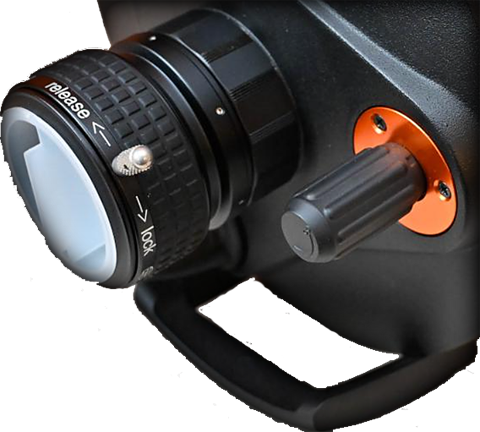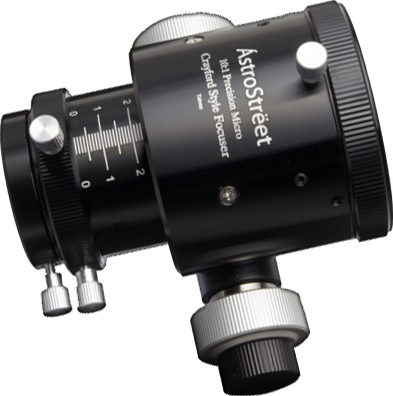The Celestron C8 XLT
You may wish to look for similarly sized Schmidt-Cassegrain telescopes from Meade, or Maktsutov Cassegrain telescopes from Sky-Watcher and others.
This Schmidt-Cassegrain telescope, SCT, is a real workhorse and an excellent compromise in terms of size, weight and cost. It sports a primary mirror 8 inches across. The primary mirror is f2.0 fast. The secondary mirror magnifies 5x, resulting in a f10 scope with a short tube. The secondary mirror obstructs the primary by 64mm or 31% in diameter. The overall obstruction is 35% or 10% by area. The tube weighs only 5.7kg and sits comfortably on a medium sized equatorial mount, such as the iOptron CEM28, Orion Sirius, Sky-Watcher EQ5, or similar. The tube comes with a convenient grab handle at the back.
Thanks to its short tube the setup is sturdy and less prone to wind shake. It is a closed optical design in that it can take some time to thermal equilibrium, say an hour before action. In turn, the primary mirror is protected against contamination, while the corrector plate can be easily removed and cleaned. In humid nights the corrector plate will dew up quickly, in that a dew tape is indispensable, and be sure it is a 12V tape (or a small hair dryer) .
The aluminum optical tube offers 2032mm of focal length and a focal ratio of f/10, which is ideal for lunar and planetary imaging tasks at native focal length with popular CMOS cameras. Of course, the use of reducers to reduce or barlows to extend focal length is possible, but within limitations, such as given by seeing, pixel (image) scale and resolution. As a rule of thumb, going beyond a focal ratio of 5 x camera pixel size will not yield any further resolution. For instance, an IMX290 based camera has 2.9オm pixels. Multiplied by 5 = about f/15, in other words, a 1.5x barlow for the C8 would be optimal for close-up imaging but not really more because the theoretical resolution limit of the C8 mirror is 0.56 seconds of arc. In spite of many improvements over the classic C8, the visual back is still the 1.25・sized with two screws to hold accessories, such as cameras and star diagonals. A modern, sturdy upgrade is the "Baader Clicklock" which accepts 1.25- or 2-inch accessories that can be fastened with a single, well, 途otation clicklock・ It should be a standard feature.
An SCT focuses by moving the primary mirror. Since the motion changes the distance of the primary to the secondary mirror, the focal length, too, changes. The closer the mirrors, the longer is the resulting focal length. The nominal back focus is about 127mm from the rear surface of the baffle nut (the focal length of 2032mm is specified for this point). Since the focus travel is very long, extension tubes can be used to manipulate the focal length to a considerable extend.
Owing to mirror curvature, a SCT is prone to off-axis aberration that makes stars away from the center look like little comets. Sensors of planetary cameras are usually too small to get into the outward area where aberration occurs, yet adjustment of the optical axis is crucial.
Celestron's standard 0.63x reducer/flattener replaces the visual back for deep sky imaging. The optimal back focus to the camera sensor is about 105mm. The reducer does not cover APS-C sensors leaving coma and field curvature beyond a corrected circle of 20mm. Alterna-tively, a 1.25" reducer, typically 0.5x, can be threaded to the nose piece of a CMOS planetary camera if a wider field at less resolution is wanted.
A rough collimation is made easy with three Phillips-head screws on the secondary mirror until a, say, defocused 2nd magnitude star is concentric with identical diffraction patterns on either side of focus. Replacing the three collimation screws, "Bob's Knobs" are thumb screws making collimation even easier without need for a tool.
A truly useful focusing assistant is a dual-speed 10:1 and 100mm long Crayford focuser with 25mm focus travel which threads to the visual back of an SCT. It accepts 1.25・and 2・imaging gear including a Ø48mm filter thread. It provides way finer focusing and is an alternative to the standard visual back or the above introduced 釘aader Clicklock・ both of which can be threaded onto the 0.63x reducer. The Crayford focuser then adjusts the camera's position to the reducer's back focus.
Celestron calls its coating technology 'StarBright XLT', with multi-layer mirror coatings and multiple layers of magnesium and hafnium fluoride on the corrector plate. Celestron specifies an overall transmission of 85.3% for their XLT design.
For further descriptions and specifications of the Celestron C8 XLT, please refer to Celestron's website.
 The front aperture with corrector plate and collimation screws.
The front aperture with corrector plate and collimation screws.
 Baader Clickstop replacing the outdated visual back.
Baader Clickstop replacing the outdated visual back.
 Crayford focuser for SCTs.
Crayford focuser for SCTs.
Preliminary Sample Images
Preliminary because all images were taken through turbulent atmosphere. Celestron C8 at native focal length, stacked and pre-sharpened in Autostakkert!3 and tuned in Photoshop.
Sample Images
Images obtained through exceptionally calm air. Celestron C8 with 1.6x barlow, stacked and pre-sharpened in Autostakkert!3 and tuned in Photoshop.










